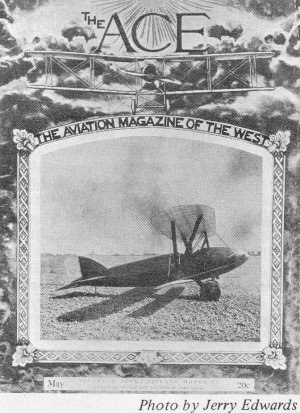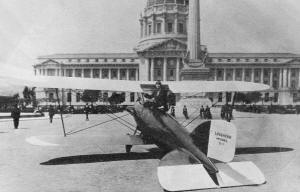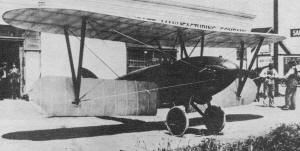|
Here
a historical article on the Loughead Sport Biplane Model S-1 Plans,
that I electronically scanned from page 46 of my purchased copy
of the October 1972 edition of AAM. Patricia Groves is the author.
All copyrights (if any) are hereby acknowledged. Click here
for the accompanying radio control model construction article and
plans on the
Loughead S-1.

Loughead Sport-Biplane Model "S-1"
A little sport biplane was Loughead's first aircraft. Only one was
made,yet it directly influenced Lockheed designs for the next
twenty years. by Patricia Groves

Loughead S1 is cover girl for May 1920 issue of The ACE,
a California-based aero magazine.

(Courtesy of Norman S. Hall) In San Francisco's Civic Center,
film starlet Mary MacLaren imparts some 1920s·type pulchritude
to S-1, and a little publicity for the April Aero Show.

(Courtesy of Tony Stadlman) Loughead Shop Superintendent
Tony Stadlman beside the newly-completed upper wing structure
of the S-1. A few years later, Tony would ramrod the development
of the Lockheed Vega.

(Courtesy of Norman S. Hall) The 92-lb. Loughead engine fits
forward the firewall with room to spare. Dual inlet, exhaust,
magnetos, oil pumps.

(Photo by William L. Rust Collection) Roll Out Day! Weighing
in at 400 lb., the Loughead S-1 exercises her (lower) wings.

Concrete molds from which S-1 monocoque fuselage emerged. To
achieve the desired ply," three layers of wood, interspersed
with two layers of binding cloth, all liberally slopped with
Casein glue, were held under 20 psi until glue was dry

Although there are traces of the well-known German Albatros,
everything about this little aeroplane denotes a refinement
and finish of the best French and English machines, and lacking
in most Amer-ican craft." (Flight: August, 1920)
Before the end of World War I, the Loughead Aircraft Manufacturing
Co. of Santa Barbara, California-like other aircraft companies the
world over began planning for the expected post-war boom in aviation.
Long before space age market research-type terms had been thought
of, Allan and Malcolm Loughead (Allan legalized the phonetic spelling
of the Loughead family name in 1934), Jack Northrop and Tony Stadlman
got all their marbles together and thrashed out future options.
Since the autumn of 1916, when it began in a corner of Bill
Rust's garage, the Loughead Co. had expanded all through his shops
at 101 State St. America was at war; investors and townspeople enthusiastically
supported their local aircraft company and the men employed there.
When Allan and Tony entered into the wildly expanding aeronautics
industry in Chicago in 1910, the industry, as such, was a mere fledgling.
It was a game, but a serious one. And, often, for keeps.
Then, when Malcolm Loughead and Jack Northrop entered the field
a few years later, they - like Allan and Tony - brought prior practical
experience in automotive and mechanical engineering with them. By
1918, all four had witnessed aviation's phenomenal growth in the
nearly 15 years since Kitty Hawk. In September 1918, when
destiny finally brought them together in Santa Barbara, the chemistry
of their individ-ual growth experiences, abilities and personalities
catalyzed into a team. Over the months that followed, they quickly
developed their own system of bal-ancing out individual pluses and
minuses - a creative bloodletting that would lead to the Sport 1
Biplane. Within the context and course of daily work, the
postwar possibilities were discussed, debated and decided on. A
new aircraft, designed to fulfill the desires yet fit the abilities
of the mass of wartime pilots then being turned out by the military,
was eventually proposed. With this as the basic criteria,
what was wanted was an honest airplane - easy to fly, and priced
so anyone could afford it. It had to be strong and dur-able, easy
to maintain, and inexpensive to operate. To compensate for the lack
of airfields and hangar space, this new aircraft would be storable
in any ordinary garage, and easily towed behind a car. And so that
it could be flown out of the fields that were available, it would
have short takeoff and landing characteristics. With
the requirements established, the group grappled with design possibilities
and construction methods. Of the then current fabricating techniques,
the monocoque type of construction received a vote of confidence
- if only it weren't such a flippin' pain in the neck. Then, with
Malcolm supplying the initial impetus, the team worked out a new
process. Eventually patented, the Loughead/Northrop/Stadlman develop-ment
was the first practical attempt to apply plastic methods to aircraft
con-struction. Prior to this development, manufacture of
wood-laminated fuselages was an expensive and time-consuming operation
because individual thin strips of wood, butted together, had to
be laminated by hand over a series of elliptical forms. Since the
adhesive on the first layer generally set up before succeeding layers
could be applied, it was impossible to subject the whole structure
to a uniform pressure to achieve the desired weld. Sometimes the
whole affair wound up pinging and twanging asunder before the total
operation was complete. And about the only "production" then was
more and better ways of swearing. Not only was it a frustrating
opera-tion in itself, but all too often separation occurred either
between the butted-together strips and/or the layered sections -
frequently at the most inopportune moments, such as during mid-flight.
The method the Loughead group developed was a process in
which individual thin strips of wood are fitted to the surface of
a male mold so that the strips, as a unit, can be temporarily fastened
to a removable form. Then, se-cure in this removable form, the com-pleted
layer is removed as a unit, ready for use at any time. When
a fuselage is wanted, the desired number of prefabricated diagonal
and longitudinal layers, or units, is selected. The already prefabricated
first layer is nestled into a concrete female mold and thoroughly
slopped with an adhesive. Next a layer of binding cloth is placed
on top and painted with the adhesive. A second prefab unit,
put in place and coated, is followed by more binding cloth. After
this layer of cloth is coated, the final wood layer is added. The
completed ply is then subjected to intense and uniform pressure
until the glue is set, after which it can be removed as a unit to
be dried. This method produces a uniformly thick shell in which
all control cables and horns can be totally en-closed within a fuselage.
After months of jawboning and experimentation, Allan, Malcolm,
Tony and Jack created the product: a neat little biplane and a whole
new construction process. When the dimensions were finally established,
Jack got down to serious drafting and Tony began work on the concrete
molds. Since the S-1 was asymmetrical in shape, two molds were built.
When engines were needed, both European and American makes
were researched. A small, economical power plane was desired - a
simple, uncomplicated engine made from easy to maintain and service
standard parts. Overall, every aspect was considered in order to
make maintenance and operation of the proposed S-1 a one-man job.
It would be the ideal airplane, an all-Loughead airplane. However,
to insure the success of the total venture, the group considered
purchasing an established four-cylinder inline to be used in the
proto-type aircraft until a Loughead engine could be fully developed
and tested. By May 1919, a nation-wide Return to Normalcy
campaign was in full swing. Even though aviation flourished - records
broken, "firsts" being made - the aeronautics industry slipped into
financial doldrums. Industry-wide, there were layoffs, cut-backs
and major changes in direction. Investors cooled. But even though
set adrift in these economic horse-latitudes, the boys at Loughead
tightened their belts and staked their remaining financial re-sources,
and future, on the Sport Bi-plane. In the months that followed,
final engineering and construction began on the forms, the molds,
tools and jigs, on all the things that would be needed to go into
aircraft production. For the moment, work on the prototype engine
was put on the back burner. Shortly after New Year's 1920,
news of an air show planned for that April reached the Santa Barbara
shop. Loughead quickly reserved space for the S-1 to debut at the
San Francisco Aeronautical Exposition. And now, with a definite
target date to shoot for, the company went all out. The decision
was made for an all-Loughead airplane now. Let's not wait. And immediately,
Allan and Bill Rust began pulling an engine together. As
the S-1 neared completion, the company looked for an experienced
ex-perimental test pilot. They found Gilbert G. Budwig practicing
his chancey trade in Venice, California. But before making his decision
to accept the job, Bud drove up to Santa Barbara to check over the
new airplane. He'd already heard a lot about "unusual innovations"
and, before risking his neck, he wanted to see what he was up against.
Bud had a long-standing habit of examining the engineering and construction
on any new airplane. A calculated risk is one thing, being a damn
fool is something else.
The
design of the S-1's lower wings performed two unconventional functions:
Instead of ailerons, each lower wing pivoted where it connected
into the fuselage providing lateral control. Secondly, a special
control lever allowed the entire lower ring to rotate 90° (after
landing) and function as a very efficient air brake. The
upper wing, built in three sections (seven-gallon gas tank located
in the center section), was held in place by latches. A V strut,
supporting both wings, was solidly bolted to the upper wing spar
and fastened to the lower wing spar by a rigid pivot pin connection.
On the ground, both wings folded alongside the tapered fuselage
to cut-outs in the horizontal stab. All this and a brand-new,
untried, untested, 25 hp, two-cylinder opposed, water-cooled engine
too! In fact, there was so much new about the airplane, Bud gave
things more than his customary thorough going-over. To his amazement,
and for the first time in his experience, nothing required reengineering.
A test site and date were picked. As Bud settled into the
cockpit on the afternoon of April 11, 1920, a pair of eager hands
laid onto the S-1's 5-1/2 foot Jacuzzi prop and pulled it through.
The little experimental engine whirred to life. While her anxious
builders watched, the plane rose cautiously from the ground. Then,
almost imperceptibly easing off at a couple hundred feet, Bud made
a solicitous and gentlemanly "pass" at his controls --- especially
roll. Surprise! She responded. With a new measure of confidence,
Bud then climbed to 1000 ft. and leveled off. Because of the newness
of the engine, he didn't want to open her up full bore. Nor, since
longevity is undeniably linked with discretion, did he care to wander
too far from a suitable landing spot. After a couple lazy
180s over the field, Bud decided to test out her landing characteristics
and the effectiveness of the air brake wing. Making a long, low,
slow-in approach, he cut throttle, and "she squatted like a duck"
before he could release the air brake lever. He taxied over
to the happy on-lookers to check out what further testing they wanted
done. Shouting over the idling engine he said he'd noticed that
engine compression seemed a bit low and he wanted to go back up
to see if he could "kick it up a little." "No. It flies!"
Allan grinned. "We'll finish testing later. Right now, let's get
'er dressed off and up to San Francisco." A few days
later, all gussied up and shiney, the S-1 attracted favorable attention
at the air show. Besides enticing potential investors in the struggling
company, there was a definite sale contingent on a flight demo.
After the show closed, Bud was called up to Redwood City, just a
few miles south of San Francisco. Here they continued test work
and attempted to improve engine compression. But a
disconcerting chain of events was already in motion, including the
government's dumping of surplus aircraft on an already strained
aviation economy. No individual buyer was interested in a $2500
airplane when he could get a brand new, in-the-crate Jenny for less
than a quarter of that amount. And attempts to jack up lagging horsepower
in the Loughead engine, as Bud would say later "were superfluous."
In our interviews, Bud staunchly maintained that all the
ideas incorpor-ated into the S-1 were sound. As far as the engine
was concerned, it wasn't a lack of dependability but just a frustrating
lack of "oomph." Today, Jack or Tony would dearly love to disassociate
all kinship with that engine. But the fact remains, within the unitary
function of the team - then and later - well, neither one of 'em
should take any blood tests. So the S-1 became a one-of-a-kind,
and one more company went belly up. Yet, if that were the entire
story, the whole thing would be a bore. Something was created that
wouldn't die or disappear: During the 20s an aeronautical incubation
was developing into a new era. Soon there was the necessary financial
as well as experimental and technological progress. The air was
supercharged with engineers, construc-tors, aviators and mechs moving
around in an exciting stream of growth and discovery. Within this
whirlpool, Allan, Jack, and Tony would get it all together again.
It was the possibilities inherent in the basic idea
that led to an improved and updated S-1, the Lockheed Vega. And
there's one helluva success! With basic Loughead engineering
and construction methods, the influence of the Lockheed Vega was
far flung and imitated. The influence of the Vega in both Douglas
and Consolidated aircraft of the period is undeniable. And, although the old Loughead Co. eventually changed hands (and
spelling), the foundation and the initial attraction was there.
Begun by Allan, Tony, and Jack, this attraction subsequently drew
the aeronautical young "comers" to fol-low Jack Northrop, Gerry
Vultee, Larry Bell, George Prudden, Kelly Johnson and others to
develop and spread their influence throughout today's aircraft industry.
S-1 a flop? Not a bit. Loughead (1920) Personnel
Interviewed: Anthony Stadlman, Shop Superin-tendent; John K. Northrop,
Engineer;
Posted November 6, 2010
|




